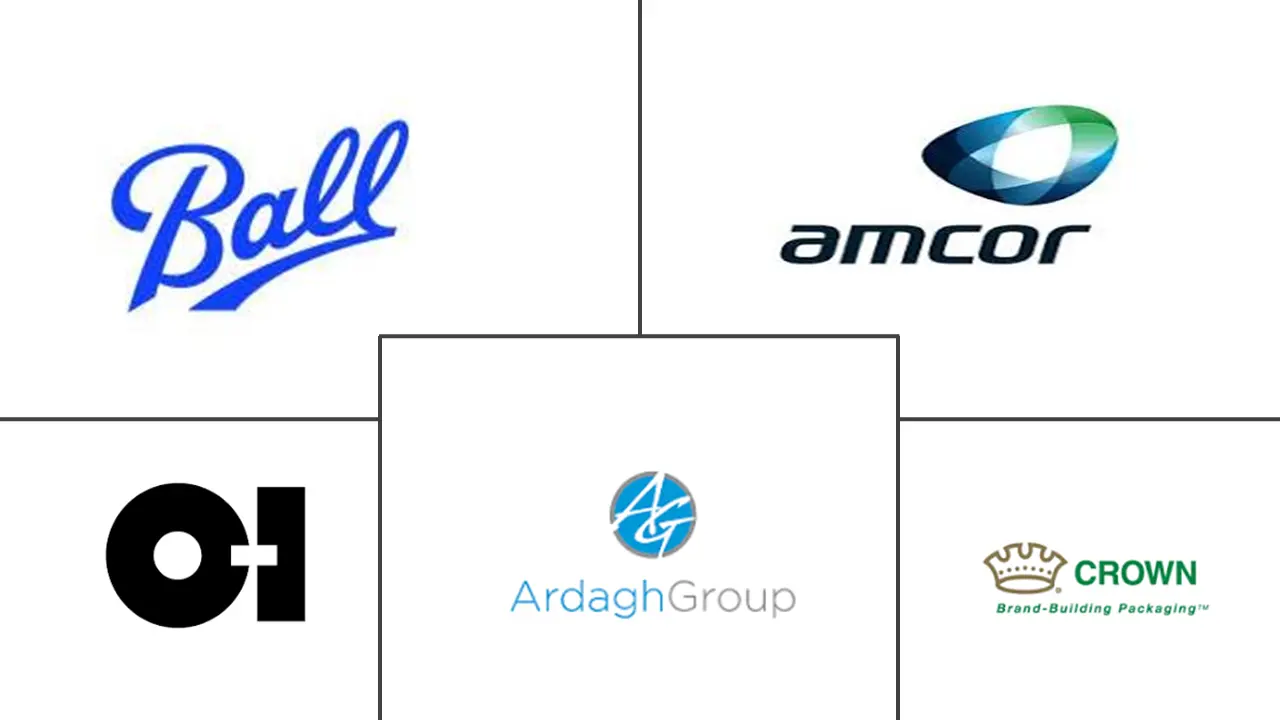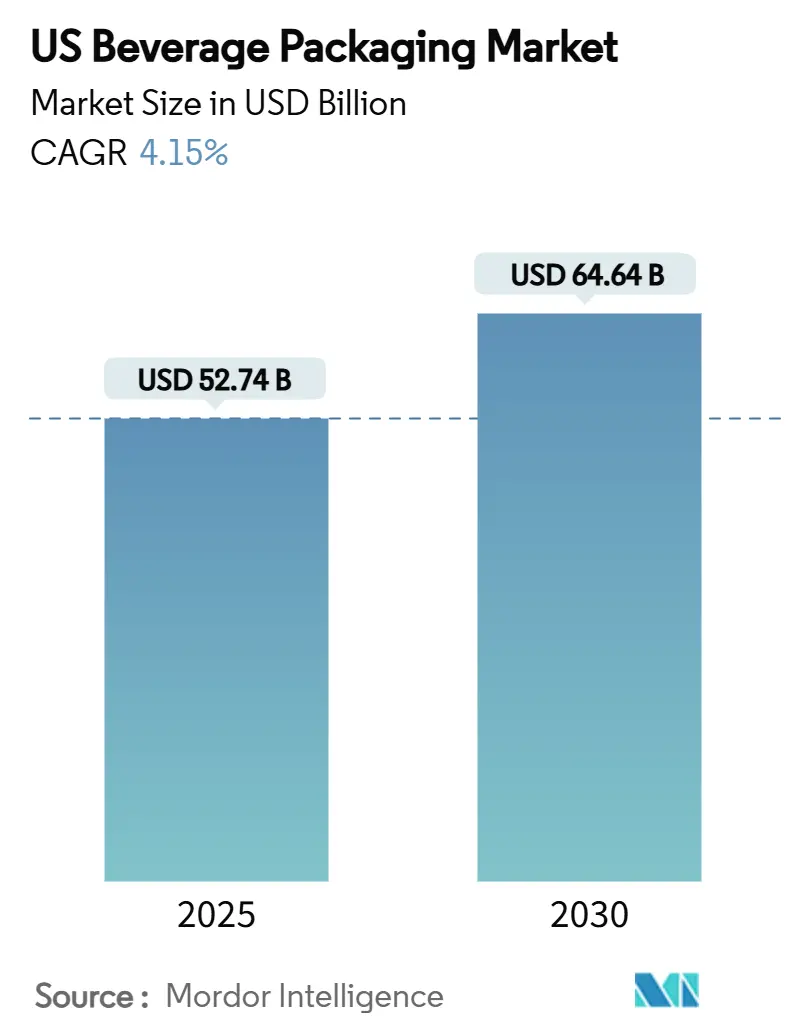
US Beverage Packaging Market Analysis by Mordor Intelligence
The US beverage packaging market reached USD 52.74 billion in 2025 and is forecast to expand to USD 64.64 billion in 2030, registering a 4.15% compound annual growth rate (CAGR). Steady value growth is underpinned by aluminum-centric strategies that align with tightening sustainability regulations, rising recycled-content mandates, and consumer preference for easily recyclable formats. Brand owners increasingly treat packaging as a cost-effective lever for carbon-reduction targets, fostering demand for lightweight metal containers and high-barrier flexible films. Supplier price actions—such as Ball Corporation’s January 2025 surcharge on 12-ounce cans—and minimum-order hikes continue to reshape cost curves for craft producers, widening the gap between large and small beverage companies. Parallel expansion of ready-to-drink (RTD) coffee, energy, and functional beverages is accelerating the migration from multilayer plastic bottles toward aluminum cans and slim bottles with premium graphics. Finally, e-commerce growth is nudging the design of “ship-in-own-container” formats that eliminate secondary corrugate, reduce breakage, and create new premiumization avenues.
Key Report Takeaways
- By material, plastic maintained leadership with 45.3% of the US beverage packaging market share in 2024, while metal driven by aluminum recorded the fastest expansion at a 6.2% CAGR through 2030.
- By product type, bottle formats held 27.8% revenue share in 2024; cans are forecast to grow at a 7.1% CAGR and overtake bottles in incremental value by 2030.
- By application, alcoholic beverages led with 32.9% share of the US beverage packaging market size in 2024; energy and functional drinks are advancing at a 5.4% CAGR to 2030.
- By packaging format, rigid formats commanded 56.1% share in 2024, whereas flexible packaging is projected to post a 5.9% CAGR through 2030, the highest among all formats.
US Beverage Packaging Market Trends and Insights
Drivers Impact Analysis
| Driver | (~) % Impact on CAGR Forecast | Geographic Relevance | Impact Timeline |
|---|---|---|---|
| Sustainability-driven lightweighting and rPET mandates | +1.2% | California, Northeast states expanding nationally | Medium term (2-4 years) |
| Surge in RTD coffee/energy drink launches | +0.8% | National, concentrated in urban markets | Short term (≤ 2 years) |
| Craft beer's switch to aluminum cans | +0.6% | National, strongest in Pacific Northwest, Northeast | Medium term (2-4 years) |
| Premium positioning through aluminum's recyclability credentials | +0.5% | National, strongest in urban and affluent markets | Medium term (2-4 years) |
| E-commerce–tailored "ship-in-own-container" formats | +0.4% | National, led by direct-to-consumer brands | Long term (≥ 4 years) |
| Tethered-cap rule (CFR Title 21 update) spurring redesigns | +0.3% | Federal mandate with state-level implementation | Short term (≤ 2 years) |
| Source: Mordor Intelligence | |||
Sustainability-driven lightweighting and rPET mandates
California’s AB 793 set a 15% recycled-content floor for PET beverage containers in 2022 that rises to 50% by 2030, providing a blueprint that New York, New Jersey, and Massachusetts lawmakers are actively considering.[1]California Department of Resources Recycling and Recovery, “AB 793 Compliance Guide,” calrecycle.ca.gov Recycled PET carries 15–25% cost premiums over virgin resin, compelling brands to invest in lightweighting that reduces polymer usage by 8–12% per container. PepsiCo’s 100% rPET shift on select water lines trimmed carbon emissions by 31% while retaining shelf integrity. Compliance-driven line retrofits add USD 0.03–0.08 per unit in logistics and processing overhead, yet brands are capturing 5–8% price lifts by marketing lower-carbon packaging.
Surge in RTD coffee and energy drink launches
RTD energy beverages now account for 37% of convenience-store RTD sales, up from 28% in 2020, and nearly every major launch uses aluminum formats.[2]Monster Beverage Corp., “Form 10-K 2025,” monsterbevcorp.com Monster Beverage derives 97% of its global volume from aluminum containers, enabling USD 7.1 billion in 2025 net sales while offsetting commodity inflation through premium pricing. Aluminum’s light- and oxygen-barrier attributes help maintain coffee aromatics and functional ingredient stability, extending shelf life without chilled distribution and lowering cold-chain costs by up to 30%. New RTD coffee stock-keeping units (SKUs) rose 73% from 2018–2023, and 60% of those used cans because of flavor preservation and decoration versatility.
Craft beer’s switch to aluminum cans
Can usage among US craft breweries jumped from 41% to 60% of packaged volume between 2017 and 2021. Aluminum’s 45% recycling rate yields material credits, while its lighter weight cuts freight outlays by USD 0.15–0.25 per case relative to glass.[3]Alpine Packaging, “Cost Savings with Aluminum Cans,” alpinepackaging.comThe trend accelerated after Ball Corporation pushed minimum orders from 204,000 to 1,020,000 cans, compelling small brewers to secure distributor intermediaries that add 15–20% to packaging expense. Digital printing can mitigate high minimums by enabling small runs with custom graphics at an extra USD 0.08–0.12 per can.
E-commerce-tailored “ship-in-own-container” formats
Direct-to-consumer (DTC) beverage revenue expansion prompted brands to rethink primary packages that double as shipping vessels. Corrugated prices climbed by USD 70 per ton in January 2025, spurring interest in secondary-material elimination. Milkadamia’s flat-pack oat-milk sheet cuts package waste by 94% and shipping mass by 85% BlueTriton’s 25-ounce aluminum bottle fetches a 25–35% premium over PET while resisting e-commerce handling damage. These formats address the USD 2.8 billion annual beverage damage cost in online channels and allow brands to bypass retail markups.
Restraints Impact Analysis
| Restraint | (~) % Impact on CAGR Forecast | Geographic Relevance | Impact Timeline |
|---|---|---|---|
| Volatile virgin resin prices | -0.9% | National, acute in Gulf Coast production regions | Short term (≤ 2 years) |
| Glass furnace capacity rationalization | -0.7% | Midwest, Southeast manufacturing corridors | Medium term (2-4 years) |
| Deposit-return expansions raising compliance costs | -0.5% | 10 states with bottle bills, expanding to 15+ | Long term (≥ 4 years) |
| Recycled PET feedstock shortages | -0.4% | National, concentrated near recycling hubs | Medium term (2-4 years) |
| Source: Mordor Intelligence | |||
Volatile virgin resin prices
Monomer price swings—particularly ethylene and paraxylene—regularly reach 25–30 c/lb in Gulf Coast spot markets, destabilizing PET cost structures for bottled water and carbonated soft drink (CSD) producers. Forward hedging is limited, causing quarterly margin compression for small bottlers.
Glass furnace capacity rationalization
O-I Glass shuttered six North American furnaces in late 2024, removing 4% of global container-glass capacity and recording USD 81 million in restructuring charges. Lower utilization raises unit costs, constraining price competitiveness against aluminum and high-barrier cartons.
Segment Analysis
By Material: Aluminum Gains Ground Through Premium Positioning
Plastic kept the largest share at 45.3% in 2024, yet metal packaging is projected to post a 6.2% CAGR, the fastest among all materials. The US beverage packaging market size for metal containers is forecast to exceed USD 27 billion by 2030, reflecting consumer preference for infinitely recyclable formats and regulatory credit for higher post-consumer recycled (PCR) content. Aluminum’s barrier properties guard flavor volatility in energy drinks and RTD coffee, supporting premium shelf pricing that offsets higher unit costs.
Ball Corporation targets 90% recycling rates and 85% recycled content by 2030, creating a closed-loop narrative that resonates with retailers pursuing Scope 3 emission cuts. Glass faces headwinds from furnace closures and energy-intensive melting, while paperboard cartons gain momentum through 97% renewable Elopak Pure-Pak structures that reach cost parity with PET at high volume. Recycled PET shortages still restrain plastic penetration despite aggressive lightweighting that cuts polymer content by up to 15%.
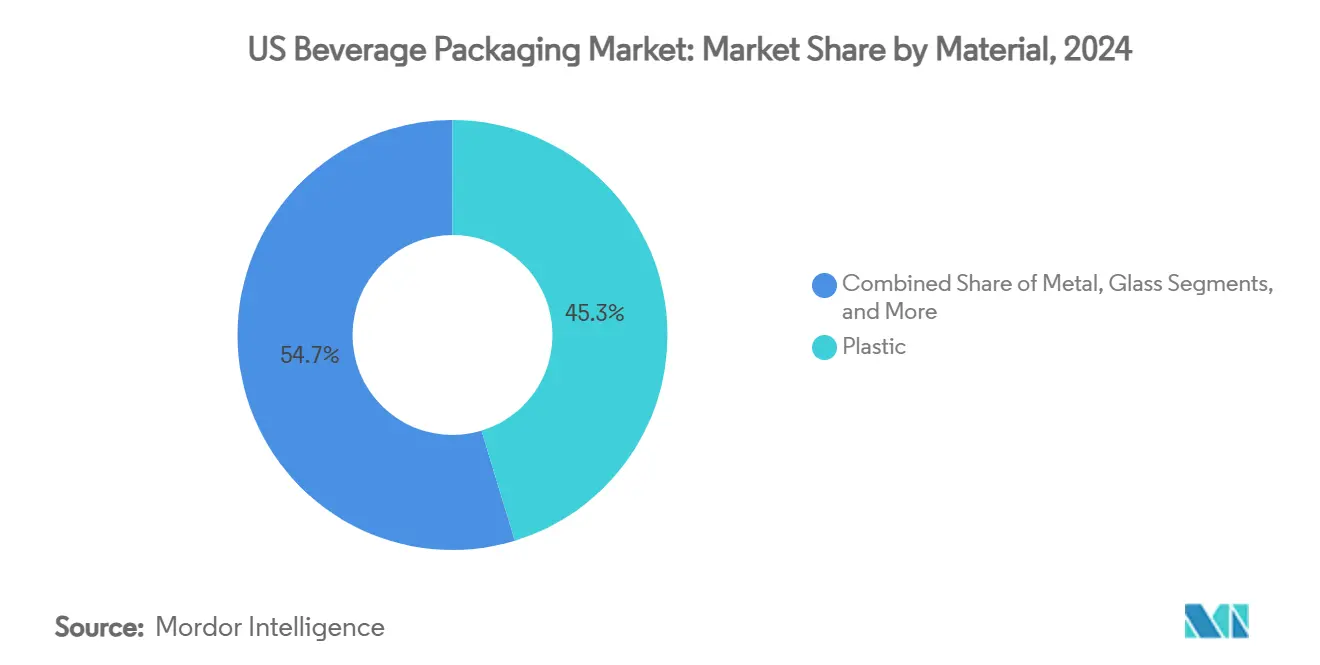
Note: Segment shares of all individual segments available upon report purchase
By Product Type: Cans Accelerate Past Traditional Bottles
Bottles commanded 27.8% of the US beverage packaging market in 2024; however, cans are pacing at a 7.1% CAGR, driven by portability, refrigeration efficiency, and customizable printing. Cans’ stackable geometry yields 20–25% freight savings over glass bottles, encouraging conversion among craft beer, flavored seltzer, and vitamin-enriched water producers.
Over 70% of 2025 beverage launches are in cans compared with 45% five years earlier, according to Can Manufacturers Institute data. Digital-print technology accelerates SKU proliferation by shrinking lead times from weeks to days, vital for limited edition RTD coffee collaborations. Bottle innovation centers on lightweight refillable PET and glass, while pouches and cartons appeal to niche use cases such as children’s beverages or aseptic dairy alternatives.
By Application: Energy Drinks Drive Aluminum Adoption
Alcoholic beverages held 32.9% share in 2024, while energy and functional drinks are expanding fastest at a 5.4% CAGR through 2030. The US beverage packaging market share for energy drinks now exceeds 12% and continues to climb with new entrants leveraging bold aluminum graphics to reinforce functionality cues.
Monster Beverage relies on aluminum for 97% of its packaging, enabling 8–12% price lifts on zero-sugar variants without volume loss. Dairy alternatives increasingly employ paperboard or flat-pack flexible films that trim package weight by up to 85%, supporting DTC subscription channels. Carbonated soft drinks maintain steady PET demand, though emerging tethered-cap rules add USD 0.02–0.05 per unit in conversion costs.
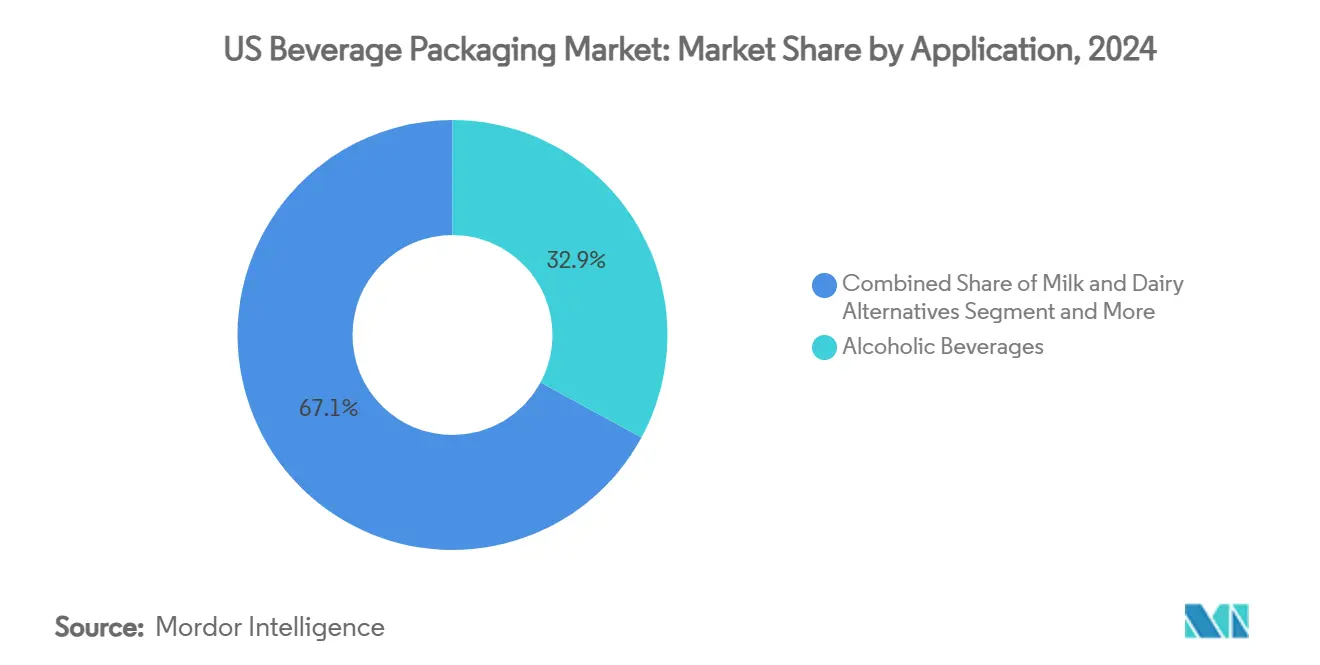
Note: Segment shares of all individual segments available upon report purchase
By Packaging Format: Flexible Gains Through Innovation
Rigid formats retained 56.1% share in 2024, benefitting from aluminum cans’ dominant position. Yet flexible packaging is forecast to rise at 5.9% CAGR, propelled by barrier-film advancements and rPET laminate rollouts. Flexible stand-up pouches slash transportation emissions by 30–40% versus glass jars, appealing to health-conscious, on-the-go consumers.
Milkadamia’s flat-pack beverage sheet exemplifies how flexible design can cut packaging waste by 94% while unlocking postal delivery economics. Rigid containers remain indispensable for carbonation retention and premium tactile appeal, so brands now adopt hybrid strategies rigid primary with flexible secondary or vice versa to meet channel requirements and sustainability targets.
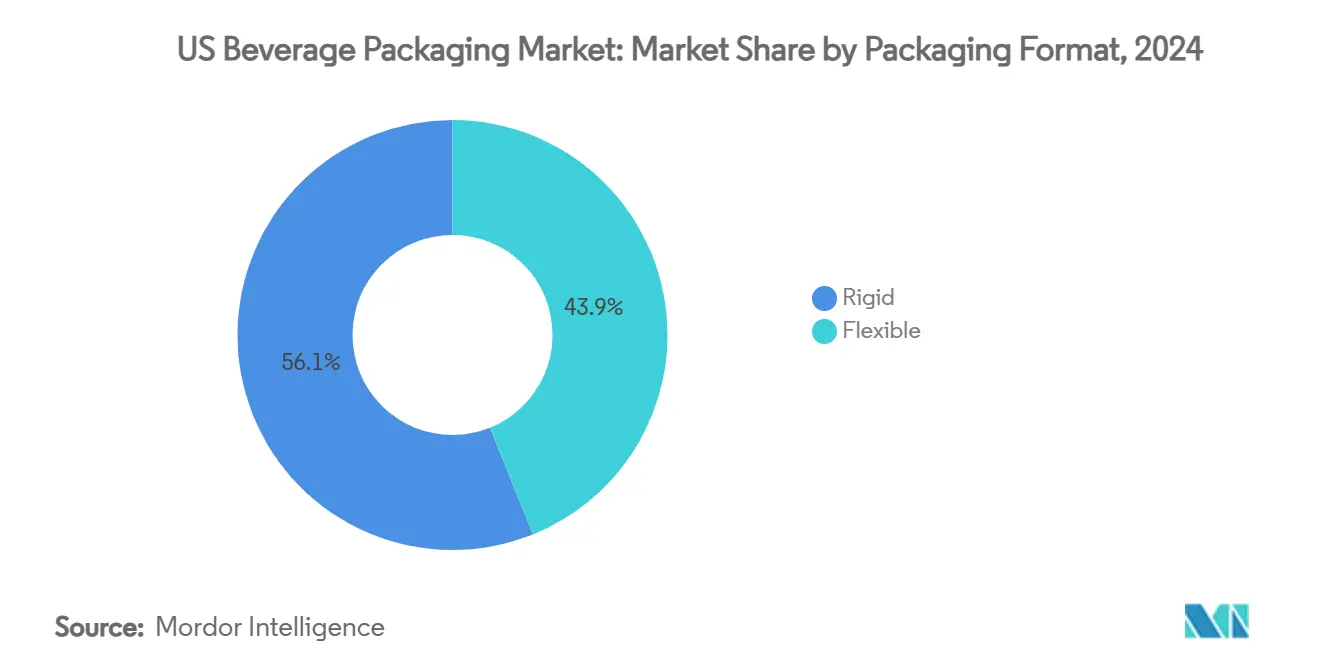
Geography Analysis
The US beverage packaging market reveals pronounced regional contrasts in regulatory rigor, recycling infrastructure, and manufacturing footprints. California’s AB 793 established the nation’s most stringent PCR mandates, and its influence is spreading as northeastern legislatures debate similar bills. Southeastern states host large-scale PET resin and aluminum can sheet production, yet these hubs also face higher hurricane-related disruption risk, prompting contingency sourcing.
Ball Corporation’s 2025 acquisition of Florida Can Manufacturing added two billion-unit capacity to serve Southeast bottlers while trimming finished-goods freight costs by an estimated 18%. In the Pacific Northwest and Northeast where craft beer densities are highest can penetration already exceeds 65%, far above the national average of 54%. Meanwhile, glass-heavy Midwest beverage corridors grapple with furnace rationalization, prompting beer and kombucha producers to sign multiyear aluminum supply agreements to guarantee availability.
Bottle-bill states such as Michigan, Oregon, and Maine record redemption rates above 85%, benefitting local PCR supply loops and lowering input costs for can-sheet rolling mills. Urban consumers display greater willingness to pay for sustainable packaging, enabling tiered pricing models that offset compliance outlays. Conversely, rural markets emphasize affordability and convenience, stimulating ongoing demand for lightweight PET bottles in large multipacks despite their lower recycling value.
Competitive Landscape
The US beverage packaging market features moderate consolidation anchored by three aluminum titans—Ball Corporation, Crown Holdings, and Ardagh Group. Together they control more than 70% of domestic beverage can output, giving them leverage over pricing, lead times, and minimum-order structures. Ball’s Florida and slated Oregon plants broaden its network, improving regional proximity while tempering freight emissions. Crown leverages global reach and proprietary Acculight can-body technology to deliver 17% segment income growth in Q1 2025.
Ardagh Group trimmed underperforming glass capacity in 2024 but expanded its Ohio can line to ease tightness during peak summer beverage season. Smaller metal-pack players, such as Arnest Packaging, are entering with USD 100 million-plus greenfield investments, yet will rely on long-term offtake contracts to secure can-sheet supply.
Competitive intensity extends to sustainability features: Ball markets 70% average recycled content cans; Crown pilots 100% PCR models for limited editions; Ardagh collaborates with BlueTriton to debut lighter, refillable aluminum bottles. Digital printing partnerships with breweries and functional-drink startups proliferate, helping incumbents tap higher-margin short-run business while protecting share from nimble newcomers.
US Beverage Packaging Industry Leaders
Owens-Illinois Inc.
Ball Corporation
Crown Holdings Inc.
Silgan Containers LLC
Berry Global Inc.
- *Disclaimer: Major Players sorted in no particular order
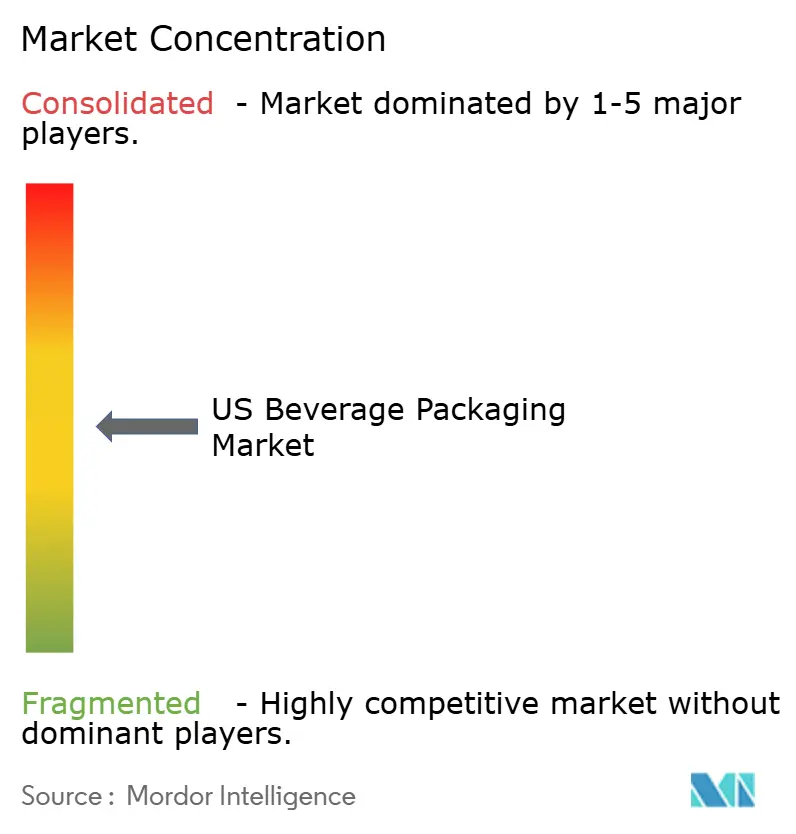
Recent Industry Developments
- February 2025: Ball Corporation acquired Florida Can Manufacturing, adding two billion cans of annual capacity and shortening lead times for Southeast customers.
- February 2025: Crown Holdings posted USD 2.887 billion Q1 2025 revenue, with EPS of USD 1.65 on 29% higher beverage-can segment income.
- January 2025: Amcor closed its Berry Global acquisition ahead of schedule, citing USD 650 million synergy potential over three years.
- October 2024: Arnest Packaging announced a USD 100 million aluminum-can plant to serve Mid-Atlantic beverage producers.
- September 2024: Elopak expanded its Arkansas carton plant with a USD 25 million second line to double output by mid-2025.
US Beverage Packaging Market Report Scope
The United States beverage packaging market studies the market segmentation based on different materials, like paper, plastic, glass, and metal. The market study focuses on various aspects, such as sustainability, production rate in beverage products, supply and demand, and the impact of COVID-19 on the market.
| Plastic |
| Metal |
| Glass |
| Paperboard |
| Bottles |
| Cans |
| Pouches |
| Cartons |
| Beer Kegs |
| Alcoholic Beverages |
| Milk and Dairy Alternatives |
| Energy and Functional Drinks |
| Carbonated Soft Drinks and Water |
| Other Beverages |
| Rigid |
| Flexible |
| By Material | Plastic |
| Metal | |
| Glass | |
| Paperboard | |
| By Product Type | Bottles |
| Cans | |
| Pouches | |
| Cartons | |
| Beer Kegs | |
| By Application | Alcoholic Beverages |
| Milk and Dairy Alternatives | |
| Energy and Functional Drinks | |
| Carbonated Soft Drinks and Water | |
| Other Beverages | |
| By Packaging Format | Rigid |
| Flexible |
Key Questions Answered in the Report
What is the current value of the US beverage packaging market?
The US beverage packaging market stands at USD 52.74 billion in 2025 and is projected to hit USD 64.64 billion by 2030 at a 4.15% CAGR.
Which material segment is growing fastest?
Metal packaging, primarily aluminum, is posting the quickest gains with a 6.2% CAGR through 2030.
Why are aluminum cans overtaking plastic bottles?
Aluminum offers superior recyclability, strong light-oxygen barriers, lower freight weight, and favorable consumer sustainability perceptions, driving a 7.1% CAGR for cans.
What impact do supply constraints have on craft brewers?
Minimum-order hikes by major can suppliers force smaller brewers into distributor contracts that raise packaging costs by 15–20%.
